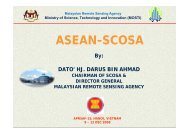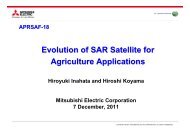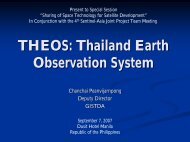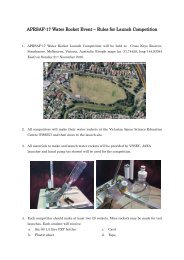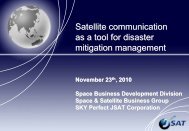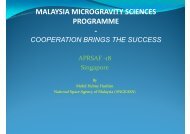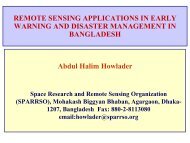ALOS Bathymetry applications (S Sagar) - APRSAF
ALOS Bathymetry applications (S Sagar) - APRSAF
ALOS Bathymetry applications (S Sagar) - APRSAF
- No tags were found...
Create successful ePaper yourself
Turn your PDF publications into a flip-book with our unique Google optimized e-Paper software.
Shallow Water <strong>Bathymetry</strong> in the AsiaPacific region using Remote SensingStephen <strong>Sagar</strong>Science & Strategy ProjectNational Earth Observation Group
Deriving Shallow Water <strong>Bathymetry</strong>from multi-spectral dataA physics‐based optimisation approach is utilisedwith multi‐spectral satellite data to derive shallowwater bathymetry up to depths of 15 – 25m.CoralSandSeagrassLord Howe Island, NSW - Quickbird 2.4mresolution multi-spectral image acquired9 th Feb 2009Spectral measurementsof substrates made onsitecan enhance thebathymetry estimationprocess
Physics-based technique• SAMBUCA - Semi-Analytical Model for<strong>Bathymetry</strong>, Un-mixing, and ConcentrationAssessment (Wettle & Brando, 2006)*Subsurface Remote Sensing Reflectance (R rs )=Water column scattering reflectance + BottomreflectanceSAMBUCA is based on expressing these componentsof R rs as a set of environmental variables*Implemented in ENVI/IDL by the Environmental Remote Sensing Group @ CSIRO Land & Water
Retrieving Water Column Depth• Pixel-by-Pixel Optimisation algorithm• Varies 3 parameters based on water properties,substrates, and depth until the error between the modelledspectrum and the measured spectrum is minimisedPoor spectral closure means less confidence can be placed in thewater properties, substrates and DEPTHS that are estimated
Model Confidence IndicatorsCocos (Keeling) South Island – Lagoon bathymetry derived from<strong>ALOS</strong> AVNIR-2 data
Integration with other bathymetry• Multi‐beamsonar• Navigationsoundingcharts• Laser AirborneDepthsoundings(LADS)
Case Study –April 2nd 2007 Solomons Tsunami• Western provinces most effected,in particular the islands of Gizo andSimbo• Almost complete destruction ofproperty and infrastructure ininundated areasField Campaign ‐ April 9th – 19th 2007Led by Dr Takashi Tomita (Port and AirportResearch Institute, Japan)Images: Tomita et al 2008Documented comprehensive inundationextent, run‐up height data and anecdotalevidence of the event
Modelling of the April 2007 Event(Tomita et al 2008)Based on 1min GEBCO global bathymetry and Marine Chart data – no DEM used
North West GizoQuickbird v AVNIR2 Case StudyQuickbird2.4m horizontal11 bit data<strong>ALOS</strong>AVNIR210m horizontal8 bit dataCase specific end‐use evaluation often needed:•Cost•Spatial resolution•Coverage•Data sensitivity & spectral characteristics
<strong>Bathymetry</strong> comparisonQuickbird<strong>ALOS</strong> AVNIR2• Very good agreement at 0‐5mdepth• Does radiometric resolution ofthe data influencedetermination at greaterdepths?• At what spatial resolution doesdetail become ‘noise’ forcertain <strong>applications</strong>?
Ghizo Island <strong>Bathymetry</strong><strong>Bathymetry</strong> derivedfrom <strong>ALOS</strong> AVNIR‐2data to facilitatetsunami modellingcalibration based onthe April 2007Solomon IslandstsunamiWork completedunder an AusAIDfunded joint GA /SOPAC (South PacificApplied GeoscienceCommission) project
Modelling for Coastal VulnerabilityCan be merged with DEM data to create a seamless model of the coastal zone
Great Barrier Reef Mapping using<strong>ALOS</strong> AVNIR-2 – Pilot StudyThe technique does notrequire existing depthmeasures to tune themodel, although theycan be incorporated ifavailable.DARLEY AND DINGO REEFLocated approx 90km north off Bowen on theQueensland CoastTherefore, it has the potential tobe applied in remote areas, suchas the Swain Reefs, where littlebathymetry informationcurrently exists.
<strong>Bathymetry</strong> Model
Validation using LADS dataSurface ComparisonLADS – IDW InterpolatedAVNIR-2 <strong>Bathymetry</strong> ModelAVNIR-2 <strong>Bathymetry</strong> ModelMedian 3x3 Filter
Validation using LADS dataSurface ComparisonR 2 = 0.82RMSE = 1.17mLADS – X AxisAVNIR2 MedianFilter – Y Axis
Validation using LADS dataDiscrete Points300 Points randomly selected in low gradient homogenous areasR 2 = 0.94RMSE = 0.5m
<strong>ALOS</strong> Shallow Water <strong>Bathymetry</strong> in theGreat Barrier Reef: Pilot study 2LADS data at 25m resolutionafter extensive editing*In conjunction with James Cook University
<strong>ALOS</strong> Shallow Water <strong>Bathymetry</strong> in theGreat Barrier Reef: Pilot study 2<strong>ALOS</strong> data at 10m resolutionwith no editing.
Further Research• Develop a clearer understanding of the influenceof spatial, spectral and data resolution onbathymetry estimation• Enable a quantitative accuracy indicator as amodel output• Long term goal – to move to an operational,quick turn-around capability
ConclusionsShallow water bathymetry derived from EO data:• Allows a fundamental data set to be created atminimal cost in comparison to othermethodologies• Enables climate change vulnerability studies inareas and fields not previously possible in manyregions• Enables studies in regions with restricted accessand/or resources



